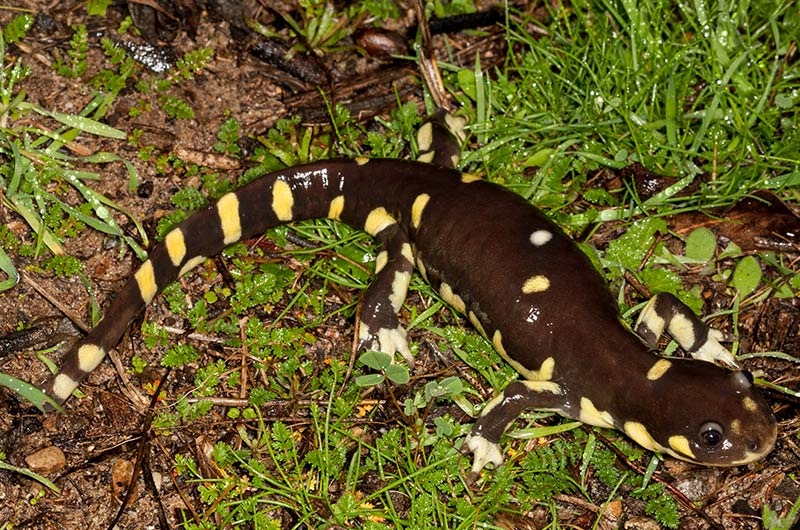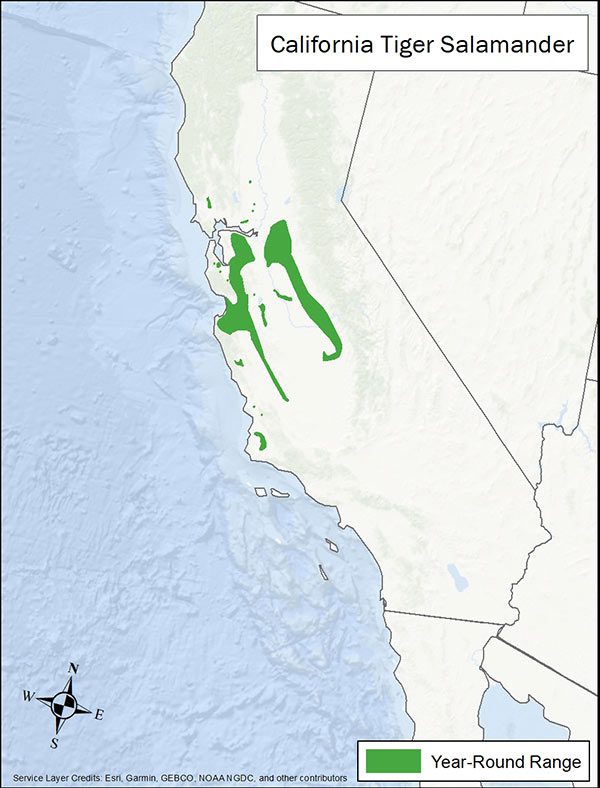LandPKS Learning
Habitat Hub

California Tiger Salamander
California tiger salamander was historically found across the Central Valley. Recently it was found on San Francisco Peninsula. While it is still found in Sonoma County, this population is geographically separated from the closest populations to the south by 45 mi/72 km.
Ambystoma californiense
Identification
The California tiger salamander is a large, stocky amphibian, 6-9.5 in/16-24 cm in length, and was previously classified as a subspecies of the eastern tiger salamander. This California tiger salamander has a broad, rounded snout and small eyes with black irises that protrude from its head. The background color on California tiger salamander is black with white or yellow splotches or bars. The belly can vary from white or pale yellow to variegated, similar to the top of the salamander. Larvae are typically pale in color but can also be spotted dark grey.
The California tiger salamander is listed as Threatened by the United States across its range, except it is considered Endangered in Sonoma and Santa Barbara Counties in California.
Observation Tips
California tiger salamander is restricted to the central part of California. It is locally common in some areas. Breeding happens after rains fill pools and ponds, usually December-February, and most individuals move less than 0.6 mi/1 km from their breeding pond. Migration to breeding ponds typically occurs following rainstorms or on rainy nights. Larvae transform in late spring or summer as water recedes. Some larvae may remain in permanent ponds. California tiger salamanders may not breed in drought years when ponds fail to fill.
Interesting Fact
California tiger salamander was historically found across the Central Valley. Recently it was found on San Francisco Peninsula. While it is still found in Sonoma County, this population is geographically separated from the closest populations to the south by 45 mi/72 km.
Ideal Habitat
The natural breeding habitat for California tiger salamanders is vernal pools. Many pools have been degraded and lost through agricultural conversion. Reproduction is most successful in fishless bodies of water. Ponds that dry completely for at least 30 days prevent bullfrogs and non-native fish from becoming established. California tiger salamanders use vacant or occupied mammal burrows of California ground squirrel or valley pocket gopher in many types of upland habitat, including annual grasslands and open foothill woodlands. Soil texture for burrows should be silty clay loam, sandy clay loam, or loam. Adults mostly eat insects, while larvae eat algae, zooplankton, aquatic insects, tadpoles, and smaller salamander larvae. They are known to travel approximately 1.2mi/2 km between upland habitat and breeding ponds, however most travel less than 700 ft/200 m.

Range map provided by International Union for Conservation of Nature
Management Activities that Benefit Species – Best Management Practices (BMPs)
Maintain vernal pools, wetlands, ponds, and surrounding rangelands that are habitat for California tiger salamander. Maintain or improve water quality in breeding ponds by reducing road runoff and pesticides in and around breeding areas. Where habitat is degraded, restoration actions should be taken. Following severe wildfires, work with local and state agencies to reduce erosion and mudslides into and around breeding areas.
Management Activities to Avoid
Avoid habitat loss through agricultural expansion and residential development, including roads near breeding ponds. Avoid introducing non-native tiger salamanders and other non-native aquatic species (bullfrogs, crayfish and fish) into the California tiger salamander habitat. Non-native salamanders will hybridize, which could make them less resilient to climate change and habitat alterations. Predatory fish and bullfrogs will prey upon juvenile tiger salamanders. Avoid eradicating ground squirrels from rangelands as California tiger salamanders use their burrows.
Other Species that Benefit from Similar Habitat Management
Other species that utilize vernal pools and temporary ponds will benefit from management for California tiger salamanders. Herons and egrets prey on California tiger salamanders.
Download
Download the California tiger salamander factsheet
Other Resources
International Union for Conservation of Nature (IUCN). 2014. The IUCN Red List of Threatened Species. Version 2021-1 Ambystoma californiense
NatureServe. 2021. NatureServe Explorer: An online encyclopedia of life [web application]. Version 7.1. NatureServe, Arlington, Virginia. California tiger salamander
USFWS. Species Information. California tiger salamander
Photo credit: Alice Abela, USFWS/Flickr
Mobile App | Data Portal | Knowledge Hub | Habitat Hub | Learning Collections | Blog | About | Contact | Support



